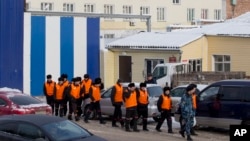The Russian correctional system will be reintroducing compulsory labor as a criminal punishment starting January 1, 2017.
According to the provision, which was originally included in the criminal code in 2011 but postponed due to a lack of facilities, compulsory labor will be an alternative punishment to prison.
Valery Maximenko, Deputy Director of Russia’s Federal Penitentiary Service, told the Russian news service TASS that the new sentencing would be better than completely isolating convicts from society. He also dismissed comparisons of the new punishment with the Stalin-era Gulag system, which also utilized forced labor.
According to Maximenko, convicts sentenced to compulsory labor would live in facilities with a much lower security level than prison. They would even be allowed to leave the facilities with permission from the authorities, but they would not be allowed to refuse or switch jobs once they are assigned.
Although the Russian constitution and the penal code ban forced labor, the Russian labor code does include an article which states that labor performed as part of a judicial sentence is not considered to be forced labor. This gives Russian authorities a loophole to use forced labor as an alternative punishment.
Currently, prisoners in Russia are allowed to work in order to earn money, but theoretically they cannot be made to do so. In reality, however, this is often not the case.
‘Forced to work for peanuts’
Ivan Pavlov, a lawyer and leader of “Team 29,” an NGO that promotes free access to information, told VOA the problem of prisoners being forced to do labor against their will is widespread in Russian penitentiaries.
“People serving time there are forced to work for peanuts,” Pavlov said. “If anyone refuses to work or stops working without a legitimate excuse, this is a gross violation of established order leading to disciplinary penalty, e.g. confinement in an inmate discipline unit or a negative character evidence preventing release on parole. Therefore, a prisoner has no choice,” he explained.
While acknowledging the Federal Penitentiary Service’s promises that the new form of punishment wouldn’t be anything like the hazardous forced labor in the Soviet period, Pavlov noted that the list of jobs or the type of labor has not yet been included in the law. It will be the penitentiary administrators who will issue work assignments based on the individual’s age, gender, and health condition, he said.
Much like in American prisons, the Russian compulsory laborers would be employed by both the state and private companies, alleviating strain on Russia’s prison system while giving the latter access to very cheap labor.
“There are also economic reasons for using the labor of prisoners, related first of all not with state projects behind schedule but with over-crowding of prisons,” Pavlov said. “However, this type of punishment will permit working for both state and private companies, so it is rather probable that they will try to increase performance at prisoners' expense.”
Russia has the ninth highest incarceration rate in the world at 447 people per 100,000. The United States stands in second place at 693 per 100,000 people.
Jim Kovpak is an American writer in Moscow who runs the Russia without BS blog.





